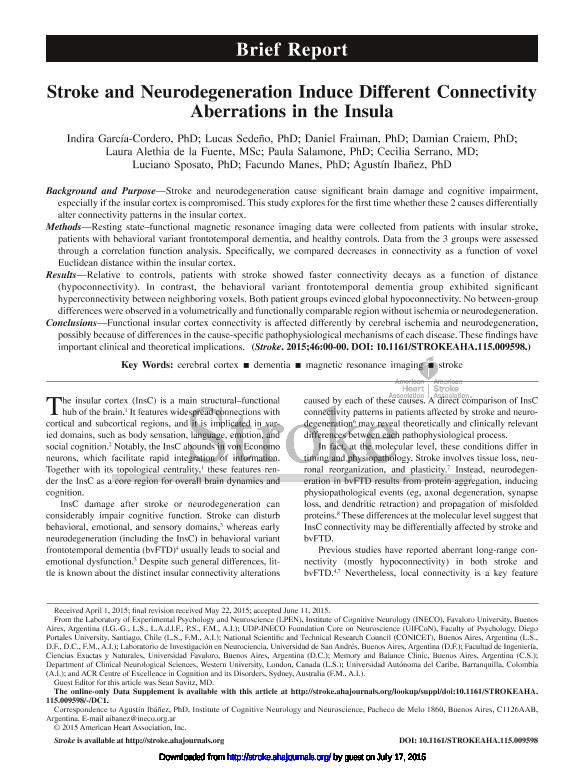Artículo
Stroke and Neurodegeneration Induce Different Connectivity Aberrations in the Insula
García Cordero, Indira Ruth ; Sedeño, Lucas
; Sedeño, Lucas ; Fraiman Borrazás, Daniel Edmundo
; Fraiman Borrazás, Daniel Edmundo ; Craiem, Damian
; Craiem, Damian ; de la Fuente de la Torre, Laura Alethia
; de la Fuente de la Torre, Laura Alethia ; Salamone, Paula Celeste
; Salamone, Paula Celeste ; Serrano, Cecilia Mariela; Sposato, Luciano A.; Manes, Facundo Francisco
; Serrano, Cecilia Mariela; Sposato, Luciano A.; Manes, Facundo Francisco ; Ibañez, Agustin Mariano
; Ibañez, Agustin Mariano
 ; Sedeño, Lucas
; Sedeño, Lucas ; Fraiman Borrazás, Daniel Edmundo
; Fraiman Borrazás, Daniel Edmundo ; Craiem, Damian
; Craiem, Damian ; de la Fuente de la Torre, Laura Alethia
; de la Fuente de la Torre, Laura Alethia ; Salamone, Paula Celeste
; Salamone, Paula Celeste ; Serrano, Cecilia Mariela; Sposato, Luciano A.; Manes, Facundo Francisco
; Serrano, Cecilia Mariela; Sposato, Luciano A.; Manes, Facundo Francisco ; Ibañez, Agustin Mariano
; Ibañez, Agustin Mariano
Fecha de publicación:
09/2015
Editorial:
Lippincott Williams
Revista:
Stroke
ISSN:
0039-2499
Idioma:
Inglés
Tipo de recurso:
Artículo publicado
Clasificación temática:
Resumen
Background and Purpose - Stroke and neurodegeneration cause significant brain damage and cognitive impairment, especially if the insular cortex is compromised. This study explores for the first time whether these 2 causes differentially alter connectivity patterns in the insular cortex. Methods - Resting state-functional magnetic resonance imaging data were collected from patients with insular stroke, patients with behavioral variant frontotemporal dementia, and healthy controls. Data from the 3 groups were assessed through a correlation function analysis. Specifically, we compared decreases in connectivity as a function of voxel Euclidean distance within the insular cortex. Results - Relative to controls, patients with stroke showed faster connectivity decays as a function of distance (hypoconnectivity). In contrast, the behavioral variant frontotemporal dementia group exhibited significant hyperconnectivity between neighboring voxels. Both patient groups evinced global hypoconnectivity. No between-group differences were observed in a volumetrically and functionally comparable region without ischemia or neurodegeneration. Conclusions - Functional insular cortex connectivity is affected differently by cerebral ischemia and neurodegeneration, possibly because of differences in the cause-specific pathophysiological mechanisms of each disease. These findings have important clinical and theoretical implications.
Palabras clave:
Cerebral Cortex
,
Dementia
,
Magnetic Resonance Imaging
,
Stroke
Archivos asociados
Licencia
Identificadores
Colecciones
Articulos(SEDE CENTRAL)
Articulos de SEDE CENTRAL
Articulos de SEDE CENTRAL
Citación
García Cordero, Indira Ruth; Sedeño, Lucas; Fraiman Borrazás, Daniel Edmundo; Craiem, Damian; de la Fuente de la Torre, Laura Alethia; et al.; Stroke and Neurodegeneration Induce Different Connectivity Aberrations in the Insula; Lippincott Williams; Stroke; 46; 9; 9-2015; 2673-2677
Compartir
Altmétricas



